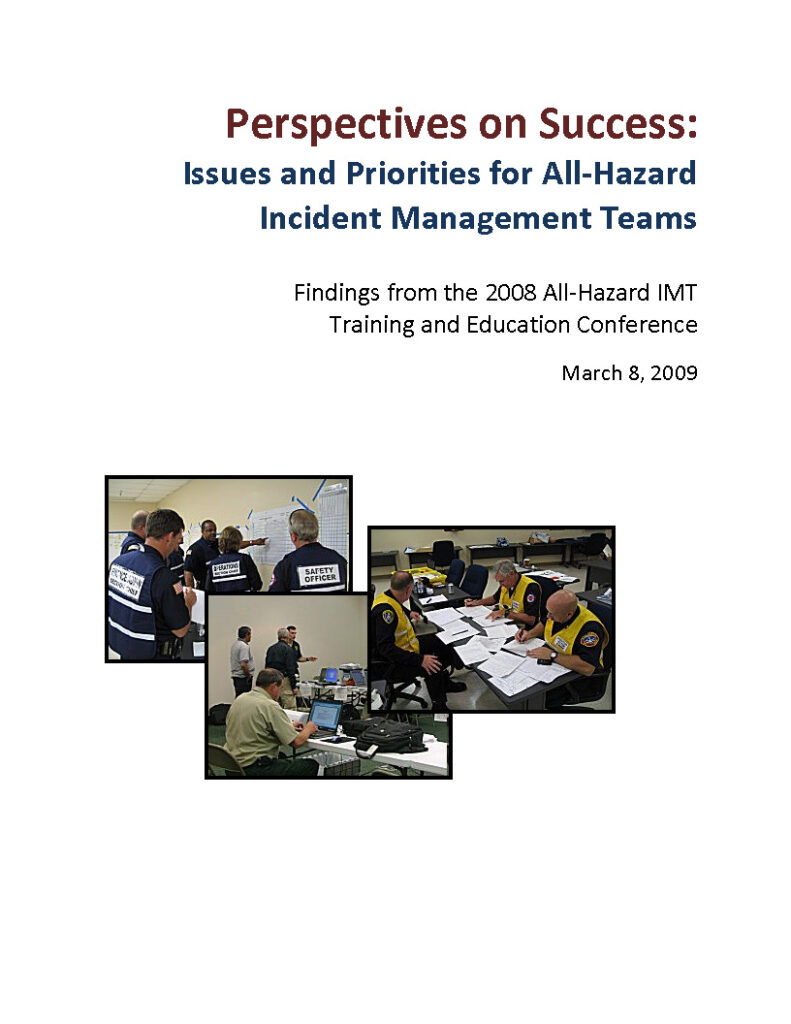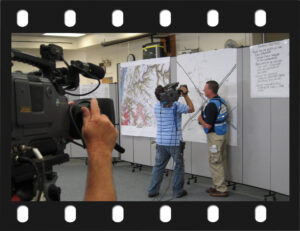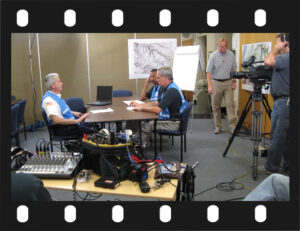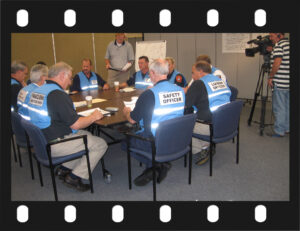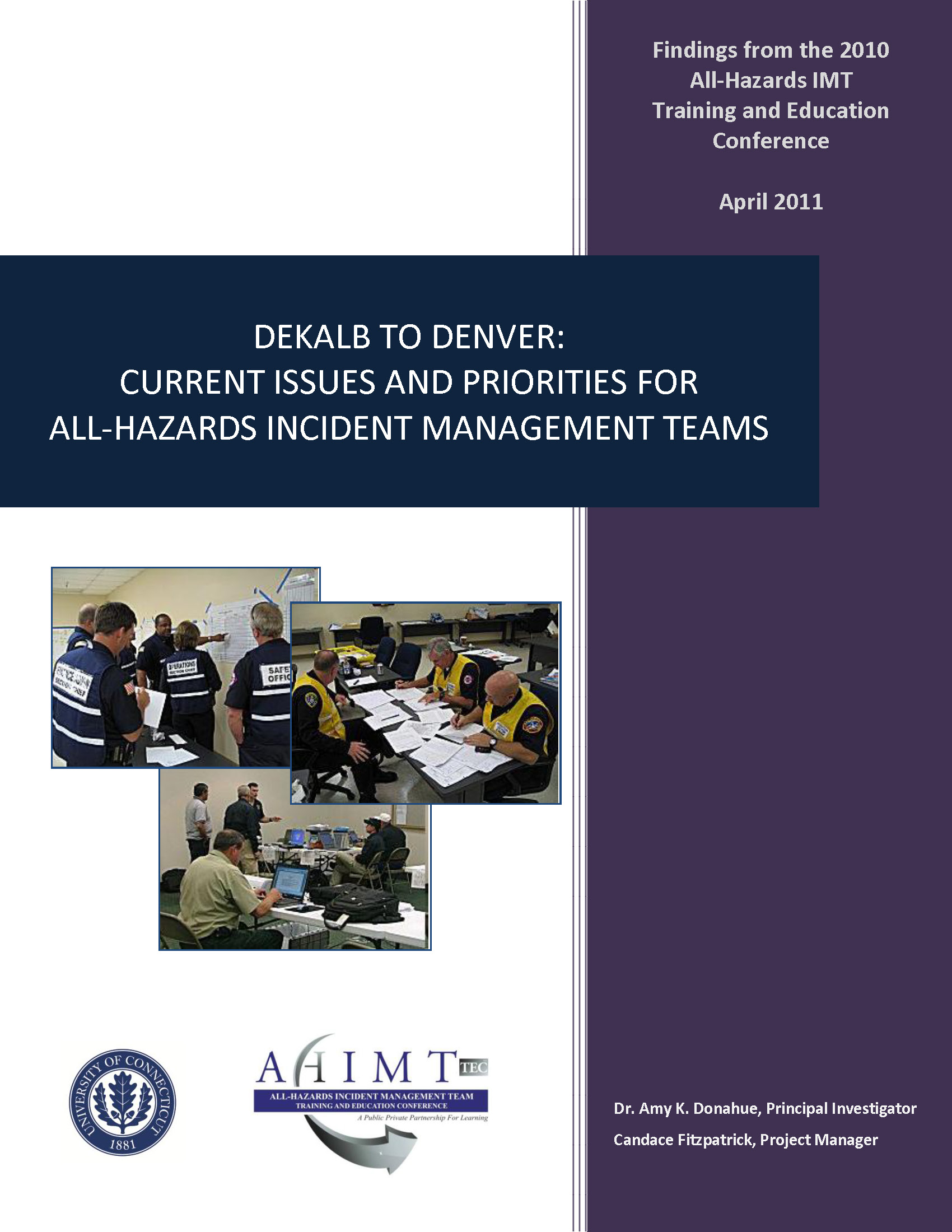The Initiating MOU | The O-305 | Field Training | Position Specific Training | Shadowing Program | The First AHIMT Conference | Development of the NIMS Planning Process Video | Results of After Action
(updated 11-30-2024)
Preparing for the 2002 Winter Olympics; then 9-11 set the stage (2000-2001)
In 2000-2001, the United States Fire Administration (USFA) was asked to provide training and technical assistance for the development of two local incident management teams – Salt Lake Valley and Wasatch Front – ahead of the 2002 Winter Olympics. The training for the 2002 Winter Olympics was arranged for by the Utah Olympic Public Safety Committee (UOPSC), which operated under a joint powers/council of government type of arrangement. The UOPSC was responsible for ensuring public safety throughout the Olympic venues, and contacted the National Fire Academy (NFA) to provide Incident Command System (ICS) training for first responders (fire, law enforcement, EMS, hazardous materials, and rescue). The desired end state was to enable the numerous response entities to work well together on incidents during the Olympics. The decision was made to utilize the National Wildfire Coordinating Group (NWCG) S-420 course, with the wildland fire emphasis and components removed (referred to as being “de-smoked”), as the capstone training course.
The results of the training provided a proof of concept that ICS training could be de-smoked and made applicable to all response disciplines. It also demonstrated when disciplines received the de-smoked ICS training together, up to and including advanced ICS courses, they were able to work together more efficiently and effectively at incidents. It proved to non-fire personnel, particularly law enforcement, that ICS was not just a “fire discipline management structure,” and also proved to the fire discipline that they did not have not be in charge of all incidents. Essentially, it provided the proof of concept for a subsequent focus group that the typically-fire ICS curriculum could be effectively made into an all-hazard curriculum and delivered to all disciplines in order to make them into a multi-disciplinary team – now known as an All-Hazards Incident Management Team (AHIMT).
After the events of September 11, 2001, the Fire Department of New York (FDNY) determined they needed to develop the capabilities of an AHIMT within their department. There were discussions whether the training and development should be presented by the United States Forest Service (USFS) using NWCG curriculum, or by the USFA. During a meeting between the FDNY, USFS, and the USFA an in-depth and and substantive discussion led to the decision that the USFS would provide the training, but the USFA was welcome to observe, participate, and provide input. Based on the process used during the UOPSC project and the process and steps used to develop FDNY’s IMT, the USFA discussed the concept of building a similar program to develop IMTs in other major metropolitan areas, possibly in partnership with I-Chiefs Metro Chiefs Section. That spawned the idea for hosting an IMT development focus group to identify the process, issues, and supporting curriculum needed to develop a viable IMT program.
The USFA initiated the Nation’s AHIMT Program (2002-2003)
In 2002, the USFA, the International Association of Fire Chiefs (IAFC), and the National Fire Protection Agency (NFPA) Metro Chiefs signed a Memorandum of Understanding (MOU) that stated the USFA would develop and maintain an All-Hazards Incident Management Team (AHIMT) program.
A focus meeting was held at the Emergency Management Institute (EMI) on July 14-16, 2003 to determine the path forward. The full attendance list can be found in the report linked below.
The focus was,
To support the NFP (National Fire Program) in the planning, development, and delivery of curricula in order to complete the rapid deployment of a training program on the principles of all-risk IMT operations and the process for IMT position certification.
The Result – The All-Hazards Incident Management Team Program
A Press Release by R. David Paulison, U.S. Fire Administrator and former chief of Metro Dade Fire-Rescue in Florida announced the joint effort.
The focus group was tasked with determining the need for Incident Management Teams in non-Wildland fire settings, the ICS positions and composition of these teams, and the training required to implement a program. After much discussion it was suggested these teams be developed by State and UASI regions. The report, Incident Management Teams Rapid Deployment of Training Focus Group Report, was released that provided a road map to developing the AHIMT program. It laid out a program that included eventual certification of positions, training gaps and needed curricula, and methods for teams to gain much needed experience. The entire report, all appendices, and additional correspondence is available in the AHIMT Library section of this site.
Development of an Introductory Course for AHIMTs (2003-2004)
Based on the focus group’s recommendations, development of an IMT course began later that year. Originally there were two “tracks” of the O-305 course: one for State AHIMTs and one for Urban Area Security Initiative (UASI) or Metropolitan Area AHIMTs. The courses were essentially the same with only minor differences. The first State AHIMT course pilot was held in Harrisburg, PA for the Pennsylvania AHIMT and the first UASI course pilot was presented in Ashburn, Virginia to the National Capital Region (NCR) AHIMT.
The pilot deliveries of the O-305 course identified a need to have a current Federal Type 1 or Type 2 IMT Command and General Staff (C&GS) member involved in the course deliveries. In response, the USFA partnered with the USFS to meet this necessity and to assist with the field training mentioned below.
The first class presented to a State AHIMT (the Rhode Island AHIMT) was held in Warwick, RI in June 2004. The first class presented to a UASI AHIMT was in San Diego to the San Diego Urban Area IMT during the summer of 2004.
The original course developed was a seven-day course known as the USFA O-305, All-Hazards Incident Management Team. Students were expected to take the ICS-100, 200, 300, and 400 and then attended the 0 305 course. The O-305 course was considered equivalent to the ICS-300 and ICS-400 courses, and certificates of completion were provided in addition to the O 305 certificate if the person had not attended either one. Although the focus group had recommended their eventual development, at that time no position specific training courses, position task books, certification process, or other supportive elements of an AHIMT program existed.
The USFA provided one full-time person and a small budget to continue developing the program.
Awarded the DHS Emergency Preparedness and Response Undersecretary’s Award (2004)


Michael D. Brown, former Undersecretary of DHS, presented the USFA’s AHIMT Development Team the Undersecretary’s Award.
“Recognizing extraordinary efforts in pioneering USFA’s All-Hazards Incident Management Team training program and broadening the Nation’s incident management capabilities.”
The plaque was displayed on the 2nd floor of the “J” building at the NFA campus. The plaque was removed and its current location is being sought.
Field Training local and state AHIMTs with Type 1 and Type 2 Wildfire IMTs (2005 – 2007)
A field training initiative was added to the AHIMT program in 2005, including adding a formal rotation of the participating AHIMTs in 2006. The training process started when the USFS and USFA at the National Multi-Agency Coordinating Group (NMAC) identified an incident that would compliment the program’s objectives. The USFA would then notify the AHIMTs (eventually by using the AHIMTs on rotation) and contact a O-305 instructor who was very familiar with the AHIMT program and a former member of an IMT to fill the role of a Field Trainer. The AHIMT was responsible to supply C&GS team members, typically 5 to 8 personnel who were available to deploy. The AHIMT and Field Trainer would rendezvous at an airport near the incident. The Field Trainer would be the group’s contact and “go-between” and would sign off the AHIMT members PTB tasks, as appropriate, and provide an evaluation of the trainees to the USFA.
Development of the NIMS ICS Position Specific Training Courses (2006-2007)
As personnel completed the O-305 course and became members of an AHIMT, a common question kept being asked, “is there a follow-up to this course? How can I learn more about the position I am going to fill?” As a result of the continuing questions and the focus group’s previous recommendation for the USFA to support the program with additional training, additional courses were needed. In 2005, the NFA/USFA’s prime contractor, ICF International, was given the go-ahead to subcontract with IMTC, LLC., to access their IMT experienced SMEs for the development of the ICS Command and General Staff Position Specific Courses (eight courses) as follow-up training. The parameters the provided to Scott Graves, ICF project manager, and the position-specific training development team to use during the development of each course were:
- Utilize the FIRESCOPE position specific course as the baseline, if one existed
- Utilize the NWCG course as the baseline, if no FIRESCOPE course existed
- Develop the course with the understanding/assumption that the students will have completed the USFA O-305 course
- Develop the course with the understanding that the attendees have no experience or prerequisite qualifications of subordinate ICS positions, so section chief courses must have knowledge, skills, and components of the subordinate positions embedded in them
The first organizational meeting for the development of the position-specific courses was held in July of 2005. The development of the first courses started in the fall of 2005 and continued into 2006. In December of 2005, the NFA hosted the inaugural pilot delivery of a NIMS All-Hazards position-specific course – the Operations Section Chief (OSC) – presented by Jon Olney and Geoff Wilford. The remainder of the Command and General Staff Beta courses and pilots were delivered in 2006-2007 and several of the unit leader courses were presented in 2008. All the original position specific courses were developed with the same four assumptions as an integral part of the Instructional Systems Design process. This is an important concept that managers who were not part of the original USFA AHIMT development program or history are unaware of. Personnel not involved in the original design assume that the position specific courses should be taken first and then the O-305 course. This runs contrary to how the original program was designed and built, and negates several additional instructional and content concepts built into the original progression of curriculum.
Train-the-Trainer Courses
The first delivery of position-specific train-the-trainer courses used a satellite video feed from NETC that was broadcast to FEMA regional sites across the nation. Although those regional sites included an SME, numerous logistical issues including restrictions on all-day satellite feeds, navigating simultaneous lunch breaks across multiple time zones, and other issues resulted in the decision that nation-wide satellite delivery would not be a suitable option for future deliveries.
The second delivery model incurred a limitation of on-campus training seat availability at EMI and the NFA in Emmitsburg, MD., during the time frame needed for the dozens of standard courses, Train-the-Trainer courses, and the new unit leader courses. This resulted in a decision in 2009 to conduct numerous courses in College Station, Texas, relying on Texas Forest Service support. Eventually, a region by region rollout of all courses was accomplished.
Due to organizational and administrative differences, the NIMS ICS position-specific training courses and the management of the NIMS Planning Process Video were transferred from the USFA/NFA to the EMI at the beginning of the 2010 fiscal year (October 2009) time frame.
Shadowing Program with Type 1 and Type 2 Wildfire IMTs (2007 – 2010)
The Field Training program ended in 2007 and was replaced by a more ad-hoc program referred to as a shadowing program. The USFA representative at the National Interagency Fire Center would notify the AHIMT program manager of a candidate incident; the program manager would notify selected AHIMTs, and the AHIMT members would tie in with the IMT at the incident. There were some programmatic and organizational policy questions and concerns whether the AHIMT members should be considered as trainees or observers, and whether NWCG qualified personnel on the IMT could sign any AHIMT PTB tasks. All costs incurred by the shadowing team had to be borne by the AHIMTs sponsor. This significantly impacted the ability of AHIMTs to participate. The organizational issues remained until the process was more formalized in 2010 (the 2010 Pilot Program.)
The First AHIMT Conference (2007-2008)
In 2008, IMTC owners Jon Olney and Geoff Wilford recognized that the growing popularity of the USFA’s AHIMT program needed a stronger national voice and coordination. Based on the extensive incident management team experience the owners had, they created the concept of sponsoring an incident management team meeting patterned after their experiences. That concept evolved into a multi-faceted conference that included a comprehensive research project to assist in determining the best path forward for the AHIMT program. The USFA assisted in the effort by connecting some of the active AHIMTs with the effort. Dan Ellis, Chicago Fire Department, and Bruce Harrison, DeKalb Fire Department were instrumental in the conference planning effort, finding a host facility, and the conference’s overall success.
The Northern Illinois University (NIU) asked to provide the facilities for the conference as a contribution and “thank you” to the first responders and the Communiversity Incident Management Team members who responded and assisted NIU during the February 14, 2008 mass shooting at Northern Illinois University in DeKalb, Illinois.
In October 2008, the conference was convened in DeKalb, Illinois on the campus of Northern Illinois University. Over one hundred AHIMT managers, training coordinators, and AHIMT members representing 30 states and Puerto Rico attended the conference to discuss issues and opportunities surrounding the development of AHIMTs. Stakeholders were asked to discuss their concerns and priorities to provide input for a national AHIMT priority research project.
The result of that research is the report, Perspectives on Success: Issues and Priorities for All-Hazard Incident Management Teams, was better known as the Dekalb Report. The report was intended to assist DHS, FEMA, and the associated and related agencies, offices, programs, and working groups in developing the strategy, infrastructure, and guidance required for a robust All-Hazards Incident Management Team capability.
The Dekalb Report Provides Peer Developed National Priorities (2008)
The research report, Perspectives on Success: Issues and Priorities for All-Hazard Incident Management Teams, simply known as the Dekalb Report, was completed by Dr. Amy Donahue, former research professor and homeland security advisor to NASA, and currently (as of 2023) the Provost and Chief Academic Officer at the United States Coast Guard Academy. Dr. Donahue is well known and respected in the response community and incident management domain.
The report was intended to assist DHS, FEMA, and the associated and related agencies, offices, programs, and working groups in developing the strategy, infrastructure, and guidance required for a robust All-Hazards Incident Management Team capability. The research guided numerous agencies and stakeholder groups.
Development of the NIMS Planning Process Video (2008-2009)
As more position-specific training courses were presented it became evident that the AHIMT program needed to standardize the NIMS ICS planning process being used in the ICS training courses. The concept of the USFA developing a video to present the ICS planning process currently used (as of 2023) by the wildland fire IMTs was presented and accepted. The first NIMS Planning Process Video organizational meeting was held in January of 2008, and work progressed rapidly to meet the deadline.
ICF International used SMEs from IMTC, LLC., to complete the design, contents, storyboard, and script during the spring of 2008. Filming was completed the week of July 14, 2008 by Level A Productions, Inc, with the assistance of the National Capital Region AHIMT facilities and team members. After acceptance by the USFA, the video was added as an instructional resource for all ICS courses. Since its release in 2009 several minor alterations and modifications have been made to the original video, but the NIMS ICS Planning Process has not been changed.
AHIMT Deployment Pilot Program (2010 – 2011)
The 2007 shadowing program, became more formalized with the NWCG-USFA Pilot Initiative in 2010. A memo from the Chair of the NWCG issued on February 3, 2010, outlined the background, goals, and intent of the initiative.
The program formalized the shadowing initiative and provided the NWCG Executive Board with some recommendations in the form of a final report.
The USFA used the report to align some of the program strategies with the NWCG recommendations.
The Denver AHIMT Conference and the Denver Report (validation of the Dekalb Report) (2010)
At the first conference in DeKalb, Illinois in 2008, attendees participated in a systematic process to identify priorities for the national AHIMT program. During the IMTC sponsored AHIMT conference in 2010 in Denver, Colorado (full information packet here), Dr. Donahue was invited back to re-validate and update the her original research.
To complete the 2010 update, the 236 registrants representing 34 states participated in an internet survey that asked respondents to provide their individual assessments of the most important priorities identified in 2008. Next, ten facilitated break-out discussions were conducted during the 2010 conference. These focus groups allowed conference participants to review and update the national priorities for AHIMTs collaboratively. Finally, a written survey was conducted at the conclusion of the conference. This survey obtained each participant’s overall assessment of the needs and issues discussed both in 2008 and during the 2010 break-out discussions to generate a final set of priorities.
The original research was re-validated and a subsequent report, DeKalb to Denver: Current Issues and Priorities for All-Hazards Incident Management Teams, was issued in April 2011, indicating the slight rearrangement of priorities. The report continues to guide numerous agencies and stakeholder groups.
Prior to the USFA defunding their AHIMT development program in 2023, the AHIMT Program had completed or were actively working on, 19 of the top 40 issues identified within the original 2008 and re-validated 2010 research projects.
AHIMT team members form the AHIMTA (2010)
At the 2008 AHIMT conference, the idea of creating an association was discussed, but didn’t get the needed traction at that time. The 2009 AHIMT Conference again demonstrated the value the AHIMT community placed on assembling in order to network, receive program briefings, and avail themselves of educational opportunities. Over 440 attendees took advantage of the opportunity.
Between the 2009 and 2010 conferences, the association gained enough momentum to move from an idea to reality. Under the guidance of Bill Easterling along with Tim McSherry, and Mike Rubenstein, the incorporation documents were filed. The initial Board of Directors was appointed during the 2010 conference, one from each FEMA region and one at-large representative. Prior to the conclusion of the conference, the Board was introduced to the attendees and the association was officially launched.
Revision to O-305 (2012-2013)
Hurricane Harvey After Action Identified AHIMT Preparedness Issues (2017-2018)
The hurricanes that made landfall in the United States during 2017 and 2018 resulted in multiple jurisdictions requesting Type-3 All-Hazards Incident Management Teams (AHIMTs) using the mutual-aid process, Emergency Support Function #4 Annex, and the Emergency Management Assistance Compact (EMAC) system. These requests resulted in the deployment of AHIMTs with a wide range of skill sets, from those that were very capable in managing the intended mission successfully, to those that arrived with significant shortfalls in training, equipment, and logistical ability to support members, and/or lacked the necessary tools and equipment to complete the mission or assignment. The issue of teams accepting requests only to find themselves deployed beyond their preparedness to self-sustain and support themselves, and/or beyond their administrative or logistical ability to manage an incident, resulted predominantly from the lack of standardization of the additional components that make up an AHIMT, and from the pressure of increased expectations when an AHIMT is mobilized on a regional or national basis. The A&M Texas Forest After Action Report developed subsequent to the 2017-2018 hurricane season included several recommendations to develop standards that would define and fully address the capabilities and preparedness of AHIMTs.
The 3-Tiered Preparedness System Developed to Prepare AHIMTs for National Tier Incidents (2018 – 2019)
Research
As a direct response to the recommendations within the A&M Texas Forest After Action Report, The USFA sought to use those recommendations to research and develop methods to improve the preparedness of AHIMTs, and assist in standardizing their preparedness and capabilities.
The research and development of the 3-Tiered Team Preparedness System (3TTPS) Concept of Operations document and the subsequent 3TTPS Implementation and Management Plan was a collaborative project between the All-Hazards Incident Management Teams Association (AHIMTA) and the United States Fire Administration (USFA), Type 3 All-Hazard IMT (AHIMT) Technical Assistance Program, using funding provided by the USFA. Several existing national models being used to determine resource preparedness were analyzed. Those frameworks provided models to develop a tiered system designed to greatly assist teams in determining their preparedness and capability to manage incidents outside their original geographic response area, without usurping a program’s autonomy.
Solution
The 3-Tiered Team Preparedness System (3TTPS) for All-Hazards Incident Management Teams (AHIMTs) is a widely accepted peer-developed and -managed national best-practice methodology for quantifying and standardizing the level of preparedness an AHIMT should possess to be able to deploy successfully in the geographic area of operation the AHIMT’s governance document identifies.
The 3TTPS helps ensure that an AHIMT’s level of preparedness in the administrative, logistical, and operational areas aligns with peer-developed national preparedness and capability standards. The standardized national preparedness levels, referred to as Tiers, were developed based on After-Action Reports from AHIMTs and the entities that requested those AHIMT resources.
USFA Collaborates with FEMA Field Operations Directorate on Supplemental Response Team Concept (2019)
AHIMTs Identify a Need for Standardizing Complexity (NIMS Complexity Guide Developed) (2020-2021)
AHIMTs Identify Need for Standardized “Model” Documents and Guidance to Coincide with the 3-Tiered Preparedness System (2020-Current)
Development of the AHIMT National-Preparedness Capability Level (PCL) Assessment Exercise (ANPAE) Leads to a Need to Define Standardized Performance Capability Metrics (2021-2022)
AHIMT National-PCL Assessment Exercise (ANPAE) Designed (2020-2022)
AHIMT ANPAE Presented as a Beta (November 2022)
USFA Defunds and Abandons AHIMT Development Program (2023)
The U.S. Fire Administration Strategic Plan Elements (2019-2023) states; We support and strengthen fire and Emergency Medical Services and stakeholders to prepare for, prevent, mitigate, and respond to all hazards. Under the guidance of its published vision: A prepared and resilient fire and Emergency Medical Services, it continued as the only Federal government agency to support the development of the All-Hazards Incident Management Team program.
The AHIMTA Assumes several Projects and Initiatives Abandoned by the USFA
Special Thanks…
The history of the AHIMT program was assembled using the numerous reports, documents, notes, emails, interviews, and conversations with former program managers, stakeholder representatives, and individuals personally involved in some aspect of its history. A special thank you to: Gordon (Gordy) Sachs, Jeff Soule, Paul Hannemann, Scott Graves, George Maier, Paul Broyles, and Geoff Wilford.




